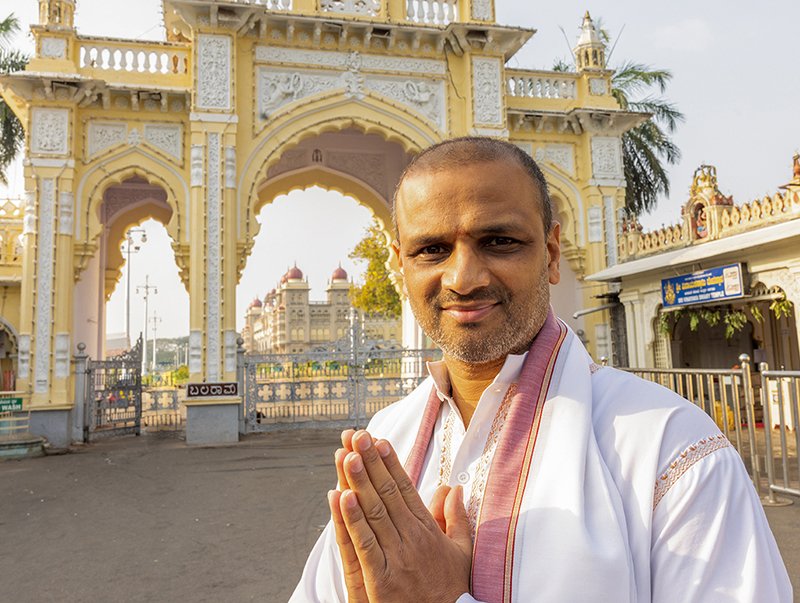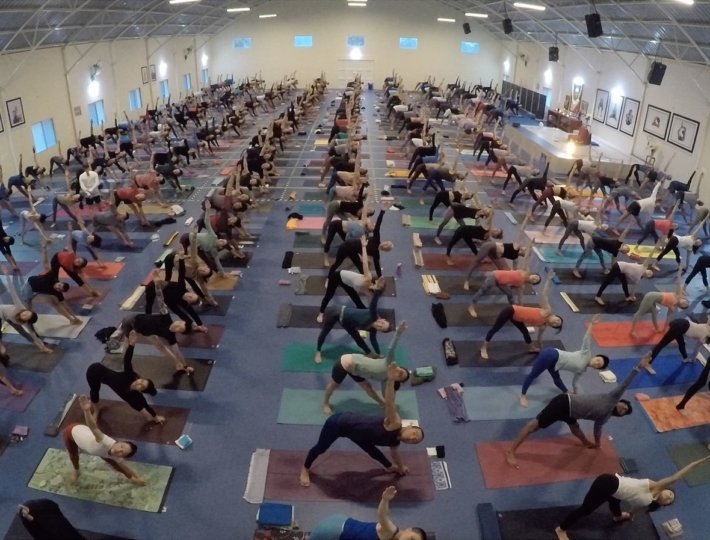Yoga is a therapeutic practice at all levels—physical, mental, emotional and spiritual. When used appropriately, it has the power to heal, balancing each of the above aspects and bringing them into harmony with each other. Even for healthy practitioners, yoga is therapeutic, working to strengthen and refine all aspects of their system. Getting out of balance and becoming sick, or sustaining an injury through practice, is a sign to reevaluate your approach, and to apply the principles of yoga to all aspects of life, not just to what is practiced on the mat.
The great 20th century yogi Tirumalai Krishnamacharya from Mysore, India represented the epitome of the art and science of yoga as a healing practice. From gaining initial recognition under the patronage of the Mysore King, Maharaja Sri Krishnaraja Wadiyar, in the 1920s and 30s, Krishnamacharya became famous for successfully treating patients with yoga therapy. Often, these patients were unresponsive to Western allopathic medicine and so several came to him as a last resort.
An innately talented healer, Krishnamacharya had a vast knowledge of yoga, and related disciplines, along with a wealth of practical experience. His approach was always to treat each person as an individual, using whatever aspects he felt the situation required. These could be a combination of āsana, prānāyāma, meditation, chanting and devotional practices, including ritual that could be tailored to the cultural and spiritual nature of the student. In this way, Krishnamacharya attempted to treat all aspects of the student in order to bring the whole being back to balance and good health.
Krishnamacharya was also highly skilled as an Ayurvedic practitioner and used analysis of the pulse for diagnosis along with the prescription of Ayurvedic herbs, oils and dietary treatments. He was instrumental in resurrecting an important text titled the Yoga Rahasya on yoga therapy from the 9th century sage Nathamuni. This was a work that was known about, but thought to have been lost forever. (The circumstances surrounding it’s rediscovery are fascinating and are described in T.K.V. Desikachar’s Nathamuni’s Yoga Rahasya published by Krishnamacharya Yoga Mandiram in Chennai.)
The Yoga Rahasya is one of few ancient works containing specific information about the use of different aspects of yoga therapy for treatment of disease. Along with āsana descriptions, it places great emphasis on the quality of the breathing and the use of prānāyāma as well as devotional practices for the purpose of healing. Both the Yoga Rahasya and Patañjali’s Yoga Sutras were cited by Krishnamacharya as an important source for his successful approach to yoga therapy.
Related: The Yoga Boom in Western Medicine
Although we can treat the symptoms of disease or injury in many different ways, healing is a process that comes from within. It happens as a result of the system’s innate intelligence, but this process can be adversely affected when we are out of balance. The aim of yoga and yoga therapy is to support the natural process of healing by bringing us back into balance on all levels. Where allopathy is required, the use of yoga therapy can support the healing process, and improve the overall outcome. I have known of several cases in which the need for asthma medication has been reduced or eradicated through consistent daily āsana and prāṇāyāma practices. I have also witnessed how daily practice with the focus on yoga as therapy has helped students with health issues, such as diabetes, blood pressure and depression.
Examining the Source of Injury or Illness
If injury has come about as a direct result of yoga practice, it is a sign that it’s time to re-evaluate your approach. From experience, it is futile for a practitioner to continue without change, hoping that things will improve. It may be the case that they are practicing too aggressively, or inattentively, or perhaps over-practicing. In any case, change in approach is needed.
Imbalances in other aspects of life may also reveal themselves in the yoga room as injuries or illness. The effect of life stresses, if left unchecked, as well as mental and emotional traumas are examples of situations that may show up in yoga as injury or generally, as chronic illness. Yoga as therapy attempts to get to the root of these problems by first correcting imbalances in the physical, mental, emotional and spiritual realms so that the individual is able to heal from within. Bringing the mind and heart to a state of attention and clarity through the various aspects of practice, such as breathing, asana and contemplative techniques is an example of this process.
Using Breath to Support Healing
Breath is an invaluable tool, which is extremely simple and available to everyone. The same parameters should be applied to breathing whether recovering from injury or not. However, in the case where injury has occurred as a result of practice, it is essential to re-examine the breathing technique and the qualities of our breathing during practice. It is unlikely that you will strain or overexert yourself when a good, healthy breathing technique is central to the focus of practice. Breath is a constant monitor of whether we are fulfilling the dual qualities of sthira (steadiness) and sukha (ease) within each āsana (posture) and vinyāsa (movement) and helps to keep the mind still and present. Often injury happens when the attention wanders and the breathing is interrupted.
A healthy breathing technique developed through āsana practice also carries over into habitual breathing, which has a positive effect at all times, helping to calm the nervous system, while bringing more energy, clarity and focus. During āsana practice, breathing should be long, deep and smooth without any straining and should be synchronized with each vinyasa. Inhalation and exhalation should be of equal length and the breath should initiate movement, not the other way around. This quality of breathing will bring a practitioner back to the present moment, cultivating more awareness to each movement and allowing the release of tensions that may be held unknowingly. Anatomically, the correct breathing technique also supports good physical alignment—key to preventing and overcoming many alignment based injuries.
Related: The Perfect Way to Breath in Ashtanga Yoga
The way the breath is used has a direct effect on the movement of prāṇa within the system and good breathing habits, along with simple prāṇāyāmas can help to regulate the flow of prāṇā within us. For instance, nādi śodhana prāṇāyāma helps to bring balance between the two hemispheres of the brain, simultaneously, enabling greater clarity and alertness along with calmness. It should be done after practice, but can also be performed during the day, and in the evening, preferably on an empty stomach. Practicing it for 10 minutes each time is a simple way to help bring balance to our system, while supporting the healing process.
The Importance of a Teacher in Yoga Therapy
A teacher who understands the therapeutic nature of yoga, and who is sensitive to each student’s individual situation will be able to make the necessary adjustments and suggestions to practice. As mentioned earlier, a student may need to address other external factors in order for the healing process to begin. How that is addressed will vary with the individual and their relationship with their teacher. It may only require a conversation that brings awareness to the source of the problem, or it may involve introducing other practices such as meditation, dietary shifts, chanting or further inquiry into yoga philosophy.
Śraddha (faith) in the ability of the teacher and the practice is also imperative. In the first chapter of the Yoga Sutras, Patañjali lists nine obstacles to yoga. The first of these is vyādhi (illnesses, disease, injury). At the top of the list, it’s mentioned that it’s necessary to first find balance and wellness in order to move toward a state of yoga. Patañjali places Īśvarapraṇidhāna (devotion to Īśvara) as the primary solution to overcoming obstacles. He states that Īśvara is a special Puruṣa (Soul) who contains the “seed (source) of all knowledge and cannot be excelled” and that “he is the ultimate guru without limitation of time.”
He is, therefore, the source of wisdom required for healing on all levels. It is believed that a teacher who comes from a genuine yoga lineage, such as Sharath Jois, connects us back to that unlimited source of knowledge within ourselves. Thus, the teacher becomes a focal point for śraddha (faith) in the process of healing. Even for those that do not have a belief in a higher power, the teacher represents a conduit for the knowledge of yoga that reaches back thousands of years, and for such a student, it can be that connection to a teacher that is able to inspire that śraddha.
Krishnamacharya’s legacy was to give us many great teachers, including Sri K Pattabhi Jois, TKV Desikachar and BKS Iyengar. Although different, all were therapeutic in their approach to teaching, and much of their success was from seeing yoga as a holistic process that should be integrated into all aspects of life, not just what we do on the mat.








Comments (0)